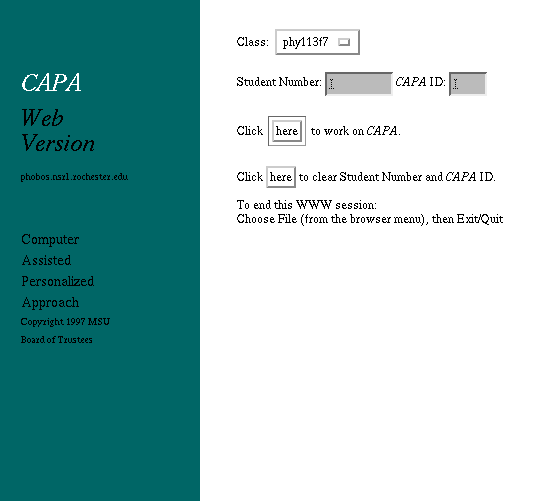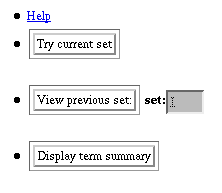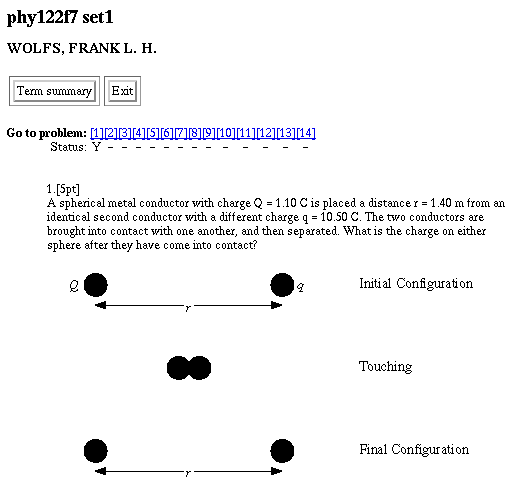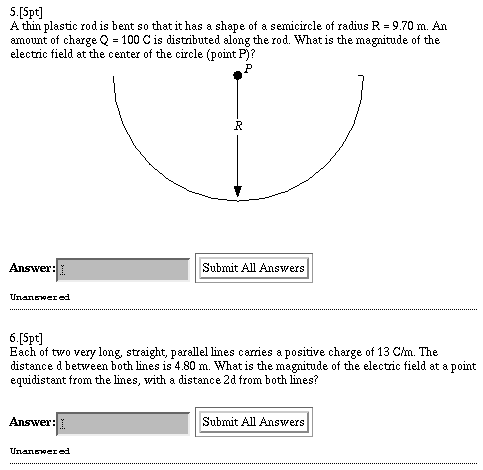CAPA Instructions
The Computer-Assisted Personalized Assignment system (CAPA), developed
at Michigan State University, is used in many of the introductory courses
in the Department of Physics and Astronomy. It is being used to generate
individualized assignments for the students. The system allows you to enter
your answers directly via networked terminals and the World-Wide WEB and
gives you immediate feedback (correct/incorrect). You are allowed to
reenter solutions to the problems before the due date.
It is strongly recommended that you answer the questions before you login
to the capa computer. Team studying and problem solving is a good way to
learn and understand, and is strongly encouraged.
Instructions: Connecting to CAPA via TELNET.
Each assignment sheet has your NAME and also a specific Personal
Identification Number (PIN). Each set has a different
PIN. The PIN number is printed on the top of your assignments
(which are available on the GOPHER server and can be printed out in Taylor
Hall).Your are now ready to start using CAPA.
- Find a terminal (a VT100 or a VT100 terminal emulator).
- Login on UHURA using your student account.
- Check that your terminal is setup as a VT100 (type: echo $term).
- If necessary change the setup to a VT100 (type: set term=vt100).
- Use TELNET to connect to the CAPA machine: telnet capa.nsrl.rochester.edu
- At the 'login:' prompt, type the username and password that
was provided to you by your instructor. The first six characters of the
username will specify your class (e.g. phy121 for Physics 121, phy122 for
Physics 122, etc.) while the last two characters specify the term (e.g.
f7 for fall 97, s98 for spring 98, etc.) Note: use lower case characters.
Your terminal should look something like:
==================================================================
Computer-Assisted Personalized Assignments (CAPA) system
-- phy121f6 Physics 121: Mechanics --
Enter STUDENT NUMBER and PIN, hit ENTER/RETURN after each
Office Hours: Wolfs: T 11.00 am - 12.30 pm (B&L203D)
De:
Klebe:
Williamson:
STUDENT NUMBER:
CAPA ID:
To exit system, just hit ENTER/RETURN
==================================================================
- Enter Student ID number and PIN for the set as prompted.
- After a successful login your terminal should look like:
==================================================================
Student's Name Section: ???
MAIN MENU
H=Help
S=Summary
T=Try set
V=View previous set
X=eXit system
COMMAND:
Enter a command from the list above and press ENTER/RETURN
==================================================================
Use S to get an up-to-date summary of your homework grades.
Use T to try to solve the current homework set.
Use V to view the answers to previous homework sets.
Use X to exit the system.
- Follow the instructions on the menu screen and enter your answers to
the problems (use T to start entering the solutions of the current
homework set).
- When you start solving the current homework set (use T from
the main menu) you will be asked with which problem you like to start.
Note that you can start with any problem and that you can chose to answer
any number of problems during each CAPA session. After entering the
starting problem number your screen will look something like:
==================================================================
1.[1pt]
Two lengths a and b are measured with a meter stick, each with a possible
error of 0.3 cm. The values obtained are a = 21.4 cm and b = 27.8 cm. What
is the maximum fractional error in the quantity (a + b) ?
Command/Answer *Unanswered
Commands :M = Main Menu :7 = go to Problem 7 RETURN = Enter/Execute
:X = eXit RETURN = Next Problem
==================================================================
You can immediately enter your answer and CAPA will tell you whether
your answer is correct or not. Note that you need to supply the correct
number of significant figures. Most problems require 3 significant figures
and answers with a different number of significant figures are in general
not accepted ! Other options are:
- :M Return to main menu (NOTE: you have to type the : !)
- :X Exit CAPA (NOTE: you have to type the : !)
- :# Goto problem number # (NOTE: you have to type the : !)
The number of times you can try to reenter the solutions to the problems
you missed is limited to a value set by your instructor. This value may
vary from problem to problem. The system records the number of times you
try each problem and the solution entered for each attempt.
- When you request a summary of your homework grades (via option S from
the main menu) your screen will look something like this:
==================================================================
TERM SUMMARY
1 2 3 4 5
12345678901234567890123456789012345678901234567890
1: 1/ 41( 2%) YN----------------------
112222222222222221211211
1 sets, total= 1/ 41 (2%)
Enter a command from the list below and press ENTER/RETURN
COMMAND:
M = Go to main menu N = Next Page P =Prev Page
==================================================================
It shows that you have answered only question 1 and 2 from set # 1 and
that your final answer for question 1 was correct. The total number of
points for this assignment is 41 and the question that was answered correctly
is worth 1 point. The average score so far is therefore 1 out of 41 (or
2%).
NOTE:
- Once a problem has been graded 'correct', and after you have exited
CAPA (by entering 'X'), that credit can not be lost.
- If the problem does not explicitly state in what units you must provide
the final answer, then you must enter the units as part of your answer.
For example, if the answer is 1.23 m, then 123 cm or 0.00123 km will also
be accepted by CAPA.
- The instructor can set the maximum number of tries for each problem
individually. This maximum number will appear on the screen when you enter
a wrong answer. The screen will also show you the number of time you already
have tried a particular problem.
- The CAPA records are only updated when your request a summary or when
you exit. If you have not logged out before the due date/time the credit
received during that session will not be recorded.
- If you connect to the CAPA system and you receive a message that you
did not exit your previous session correctly, you should make sure that
you did not forget to logout from your previous session. If you are
still logged in elsewhere when you start a new CAPA session, the credits
received in this second session will not be recorded.
- If you encounter any problems using the CAPA software or if you have
any problems connecting to the CAPA machines (for example when you are
not able to login because of time-outs) report them to Prof. Wolfs using
email (email address is wolfs@nsrl.rochester.edu).
Instructions: Connecting to CAPA via the WEB.
You can also use a WEB browser to enter your solutions to the homework
assignments. The use of the WEB browser has the advantage that in most cases
you will see the graphics on the screen, in exactly the same way as they
appear on the printed versions of the assignments. In this section we will
discuss the procedure to be used to enter your solutions via the WEB.
- Find a computer with a WEB browser (Netscape or Internet Explorer).
- Use the WEB browser to connect to the following location:
http://capa.nsrl.rochester.edu/CAPA/class.html
Note: you need to use capital and lower-case characters in exactly
the way they are listed above. /CAPA/class.html is not the same as /capa/class.html
! It is probably best to define a bookmark that points to the CAPA login
page.
- You will see the following screen appear on your WEB browser:

- Select the correct class by using the pop-up menu after "Class:"
- Enter your user id and PIN number.
- Click the "here" button to start to work on CAPA.
- You will now see the main CAPA menu appear on your screen:

- When you click on "Display term summary" you will see a summary
of your performance so far:

- When you click on "View previous" you will be able review
the correct answers on a previous set.
- When you click on "Try current" you will be able enter the
solutions to the current assignment (an example of a screen associated
with the current set is shown in the Figure on the next page). You can
directly go to the problem by clicking on the corresponding number on the
top of the screen. You will also immediately see the status of your assignment.
A Y in the status line indicates that your have answered that problem correctly,
an N indicated that you have answered that problem incorrectly, and a -
indicates that you have not answered that problem yet.


- You can answers the problems in any order, and as many as you want
at any given time. Please note that the computer will not check your answers
until you hit the "Submit All Answers" button. Since checking
your answers is time consuming, it is often best to wait with checking
your answers until you have entered solutions to several problems.
- Please make sure to quit your WEB browser when you are finished using
CAPA.
NOTE: you can use both WEB access and telnet access to enter your
solutions to the assignments. They both access the same data base.
Units
For many problems, you will be required to enter the units as part of
the answers. The tables below list the units that are recognized by CAPA.
Note that you can combine units in this table in order to create the units
appropriate for the problem you are working on. For example, if you are
required to calculate the density of a solution, you can use as units kg/m^3
which is a combincation of two base units (kg and m). However, CAPA would
also have accepted a solution in tehrms of g/cm^3 etc. etc.
Base Units
| name |
(CAPA) symbol |
comment |
| meter |
m |
length |
| kilogram |
kg |
mass |
| second |
s |
time |
| ampere |
A |
electric current |
| kelvin |
K |
thermodynamic temperature |
| mole |
mol |
amount of substance |
| candela |
cd |
luminous intensity |
Prefixes
| Prefix |
(CAPA) symbol |
factor |
| yotta |
Y |
10^{24} |
| zetta |
Z |
10^{21} |
| exa |
E |
10^{18} |
| peta |
P |
10^{15} |
| tera |
T |
10^{12} |
| giga |
G |
10^9 |
| mega |
M |
10^6 |
| kilo |
k |
10^3 |
| hecto |
h |
10^2 |
| deci |
d |
10^-1 |
| centi |
c |
10^-2 |
| milli |
m |
10^-3 |
| micro |
u |
10^-6 |
| nano |
n |
10^-9 |
| pico |
p |
10^{-12} |
| femto |
f |
10^{-15} |
| atto |
a |
10^{-18} |
| zepto |
z |
10^{-21} |
| yocto |
y |
10^{-24} |
Derived Units
| name |
(CAPA) symbol |
unit |
comment |
| gram |
g |
0.001 kg |
mass |
| hour |
hr |
3600. s |
time |
| minute |
min |
60 s |
time |
| pound |
lb |
0.45359237 kg |
mass |
| ounce |
oz |
1.77185E-3 kg |
mass |
| inch |
in |
2.54 cm |
length |
| foot |
ft |
12 in |
length |
| mile |
mi |
5280 ft |
length |
| yard |
yd |
0.9144 m |
length |
| nautical_mile |
n_mi |
6080 ft |
length, nautical mile (UK) |
| astroUnit |
AU |
1.49598E11 m |
length, mean earth to sun distance |
| acre |
acre |
4840 yd^2 |
area, acre |
| hertz |
Hz |
1/s |
frequency |
| litre |
L |
10^3/cm^3 |
volume |
| newton |
N |
m*kg/s^2 |
force |
| pound_force |
lbf |
4.44822 N |
force |
| dyne |
dyn |
1E-5 N |
force |
| pascal |
Pa |
N/m^2 |
pressure, stress |
| bar |
bar |
1E5 Pa |
pressure |
| mmHg |
mmHg |
1.33322E2 Pa |
pressure, millimeter of mercury |
| torr |
torr |
1 mmHg |
pressure |
| atm |
atm |
760 torr |
pressure, standard atmosphere |
| joule |
J |
N*m |
energy, work, heat |
| electronvolt |
eV |
1.6021892E-19 J |
energy |
| calorie |
cal |
4.1868 J |
energy |
| Btu |
Btu |
1.05506E3 J |
energy |
| watt |
W |
J/s |
power, radiant flux |
| coulomb |
C |
A*s |
electric charge |
| volt |
V |
J/C |
electric potential, electromotive force |
| ohm |
ohm |
V/A |
electric resistance, use this in /ANS |
| ohm |
ohms |
V/A |
electric resistance |
| ohm |
Ohm |
V/A |
electric resistance |
| ohm |
Ohms |
V/A |
electric resistance |
| siemens |
S |
A/V |
electric conductance |
| farad |
F |
C/V |
electric capacitance |
| tesla |
T |
V s/m^2 |
magnetic flux density |
| weber |
Wb |
V*s |
magnetic flux |
| henry |
H |
V*s/A |
inductance |
| radian |
rad |
m /m |
plane angle |
| degree |
deg |
1.745329E-2 rad |
plane angle (Pi rad=180 deg) |
| steradian |
sr |
m^2 /m^2 |
solid angle |
| lumen |
lm |
cd*sr |
luminous flux |
| lux |
lx |
cd*sr/m^2 |
illuminance |
| becquerel |
Bq |
1/s |
activity (radioactive) |
| gray |
Gy |
J/kg |
absorbed dose (of radiation) |
| sievert |
Sv |
J/kg |
dose equivalent (dose equivalent index) |
Send comments, questions and/or suggestions via email
to wolfs@nsrl.rochester.edu and/or visit the home
page of Frank Wolfs.




